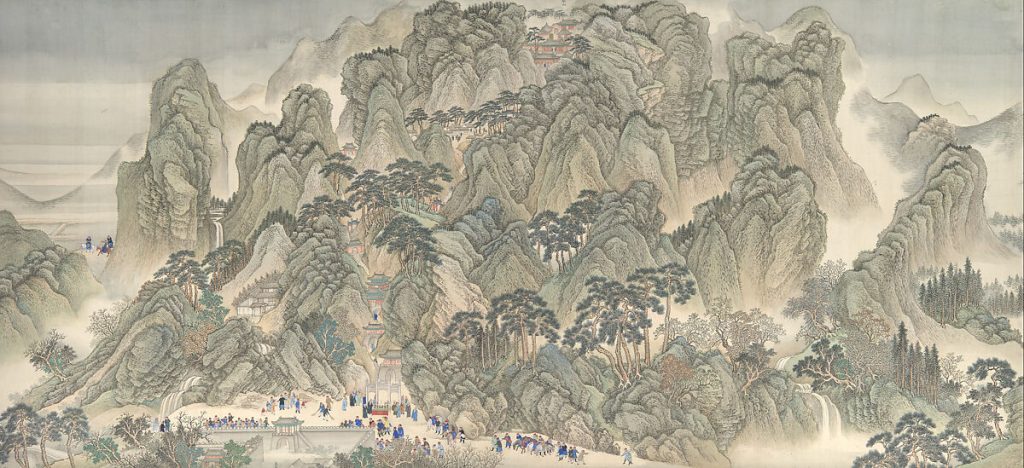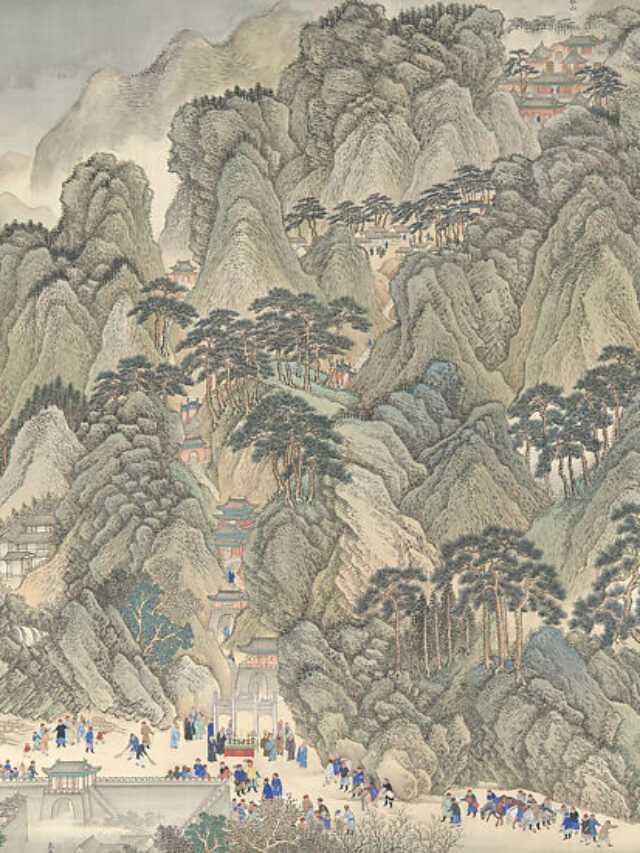When we think of landscape, we think of the mountains, the meandering streams, flora, and fauna. But nobody has contributed more to landscape paintings than the Chinese. For centuries, simple Chinese landscape paintings have bewitched viewers with their serene and calming beauty, intricate detail, and profound symbolism. Rooted in ancient traditions and philosophical principles, Chinese landscape paintings offer a window into the country’s natural landscapes, a glimpse of the auteur’s emotions, and the entity’s cultural and spiritual heritage.
What Is Chinese Landscape Painting?
Chinese landscape paintings stand as a testament to the profound connection between art, nature, and philosophy. Landscape paintings are revered in China to date. Ancient Chinese landscape paintings never used oils, relying only on a brush and ink or coloured pigments. The paintings are borne on paper and silk. Usually, a traditional Chinese landscape painting may be seen on scrolls, hanging scrolls, folding screens, and lacquerware. Chinese painting landscapes often pigmented detailed brushstrokes. The technique is known as ‘Gongbi’. Another popular technique is the ink and wash painting often known as the ‘literati’ paintings.
A Historical Overview of Chinese Art Landscape Painting
The tradition of landscape painting in China dates back thousands of years, during the Shang and Zhou dynasties (16th century BCE – 256 BCE). However, it wasn’t until the Tang dynasty (618-907 CE) that landscape painting began to flourish as an independent genre. During this period, artists such as Wang Wei and Li Cheng pioneered the style. Wang Wei’s famous Chinese landscape painting, titled ‘Wangchuan Villa’, is often noted by critics for bringing forth the monochromatic and ink-wash style. While the landscapes are definitely inspired by the locations, the Chinese landscape paintings don’t aim at reproducing the work, but rather capturing the emotive state of the painter.
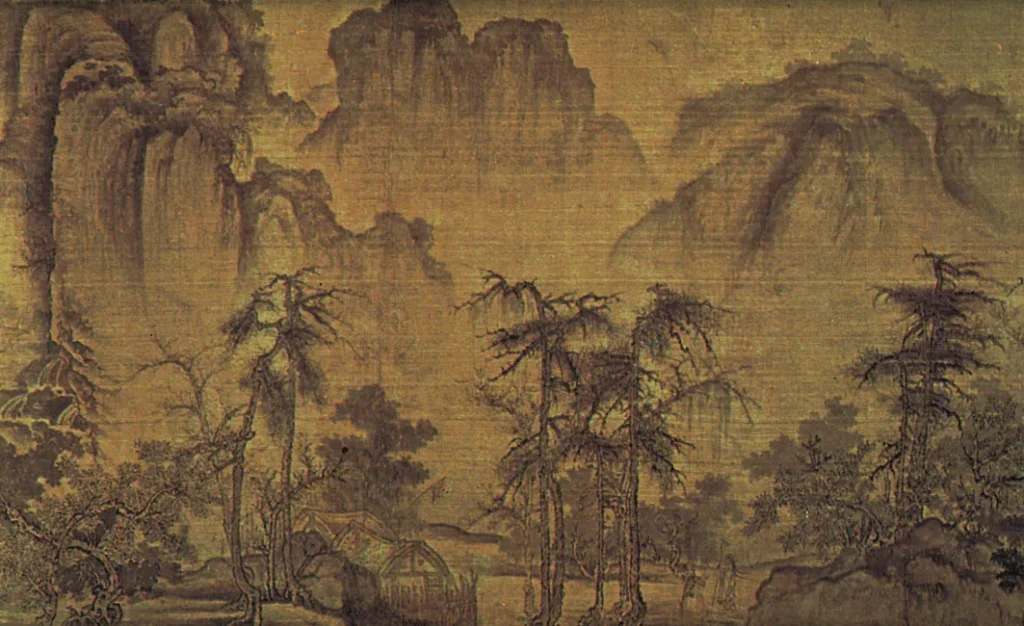
Courtesy – Britannica
The Song dynasty (960-1279 CE) is considered the golden age of Chinese landscape painting. Artists like Fan Kuan, Guo Xi, and Xia Gui perfected the ‘Northern Song’ style, which was proliferated by Jing Hao. This style of Chinese landscape paintings was characterized by meticulous detail and atmospheric perspective, which are the core traits of Impressionism. These artists sought to capture the essence of nature, using brushwork, ink, and subtle washes. The Chinese ink landscape paintings done in this period saw humans as merely specks in the vast cosmos. This is extremely evident in the paintings, which transcend the frame to transport the viewers to the tranquil nature.
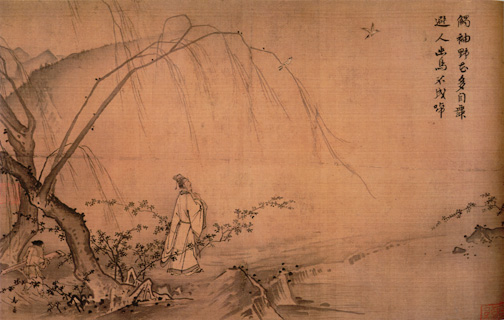
Courtesy – Washington University
Between 1127 and 1279 CE, the ‘Southern Song’ style emerged. It emphasizes a more intimate and subjective approach to Chinese landscape painting. At this time, painters were interested in exploring the connection between landscape painting and poetry. As is evidenced in Ma Yuan’s ‘On a Mountain Path in Spring’, even though the landscape takes the viewer’s attention, one cannot help but look at the inscription. The inscription seems to be a work of a Romantic like William Blake. The paintings are characterised by symmetrical lines, established perspective, and the coherence of space. Another artist, Xia Gui favoured a softer, more lyrical style, using light, shade, and texture to convey the ephemeral beauty of nature.
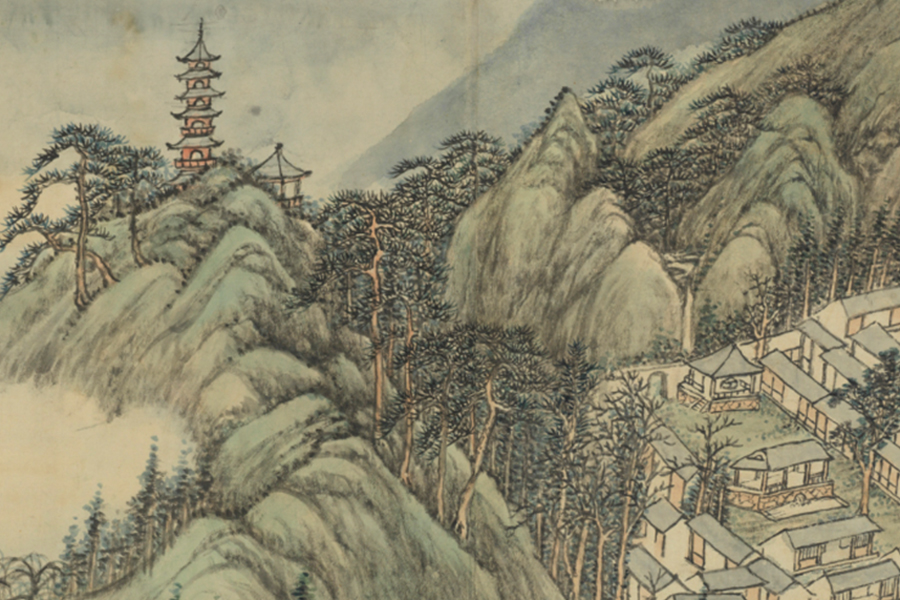
The Ming dynasty (1368-1644 CE) saw a revival of classical painting techniques, with artists such as Shen Zhou and Wen Zhengming continuing the teachings of Yuan and Song styles. This period also saw the rise of the ‘blue-and-green’ landscape style, characterized by rich colours, bold compositions, and a sense of drama and movement. By the Qing dynasty (1644-1912 CE), free brushwork had become the norm. Chinese landscape painting had become highly refined and diversified, with artists like Wang Hui, Wang Yuanqi, and Shi Tao dominating the art scene. The Qing dynasty also saw the decline of the imperial court and the rise of new social and cultural movements, with painters like Bada Shanren and Shitao, who rejected conventional artistic norms in favour of personal expression and experimentation.
Chinese Art Landscape Paintings: Techniques and Materials
Chinese landscape painting is characterized by its use of the ‘Four Treasures of the Study.’ It refers to the brush, ink, paper, and inkstone. The brush is typically made from animal hair (such as goat, wolf, or rabbit) and comes in various sizes and shapes, each suited to different painting styles and techniques. Chinese ink, made from soot and water, is ground into a smooth paste on an inkstone before being applied to the paper with the brush. Chinese paper, known as xuan paper or rice paper, is highly absorbent and flexible, allowing for a wide range of brushwork and washes.
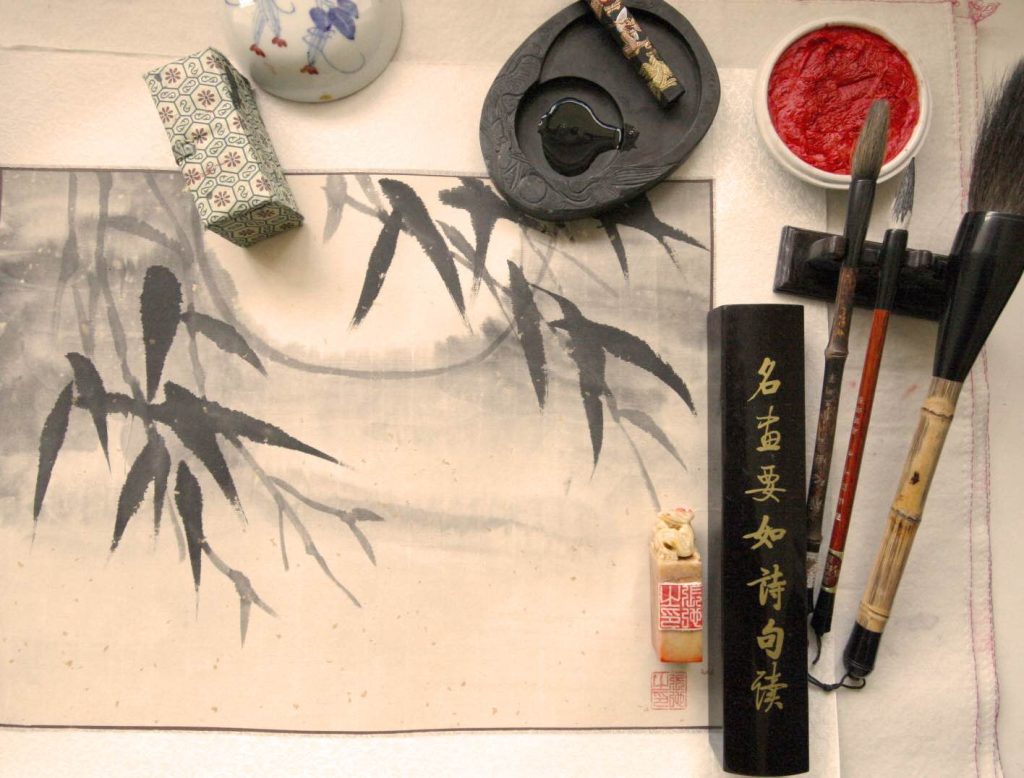
In Chinese landscape painting, artists use a variety of techniques to capture the essence of nature. These include the ‘boneless’ painting (sansuibizhong), which requires fluid, expressive brushwork as the painter doesn’t outline their subject but rather manoeuvres the paint first. The ‘axe-cut’ texture strokes (bafangwen), create a sense of depth and dimensionality, often used to create the tactile points of stones by holding the brush diagonally. Some also use the ‘dry brush’ or ‘flying white’ (feibai) technique, which adds texture and contrast to the painting by adding irregular white lines to the surface.
Recurring Motifs and Symbolism in Chinese Landscape Paintings
Chinese landscape painting is imbued with rich symbolism and philosophical significance, reflecting the artist’s worldview and spiritual beliefs. Mountains, rivers, trees, and rocks are not merely representational elements in Chinese landscape paintings but symbols of cosmic forces and existential truths. Mountains, in particular, hold a special significance in Chinese culture, symbolizing strength, stability, and enlightenment. The towering peaks, jagged cliffs, and winding valleys depicted in Chinese landscape paintings evoke a sense of awe and reverence for the natural world, while also serving as metaphors for the Sisyphean lives of humankind.
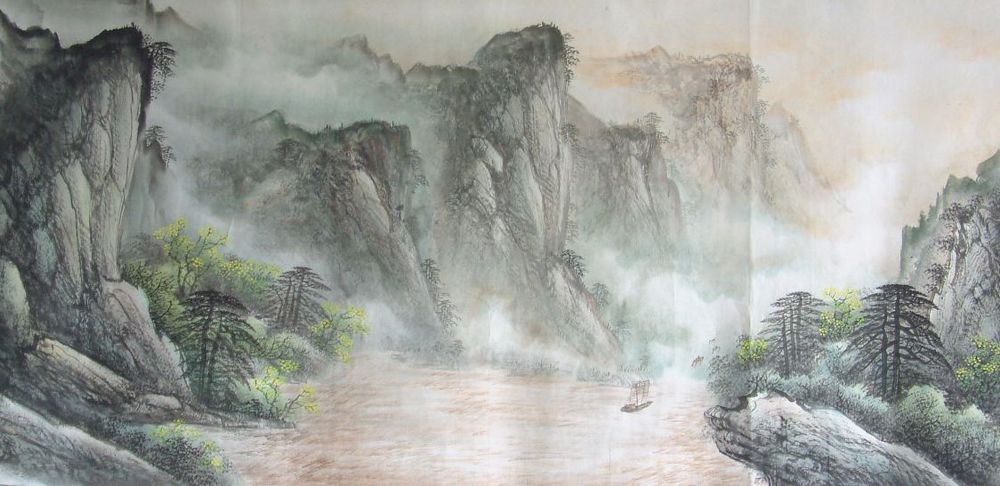
Water is another important symbol in Chinese landscape painting, representing the flow of life, the passage of time, and the cyclical nature of existence. Rivers, streams, and waterfalls are often depicted with flowing brushstrokes and subtle washes, conveying a sense of movement and vitality. Trees and rocks, meanwhile, are symbols of resilience, perseverance, and inner strength. Pine trees, with their evergreen needles and gnarled branches, are often associated with longevity and wisdom, while rocks, with their rugged textures and weathered surfaces, symbolize the enduring power of nature.
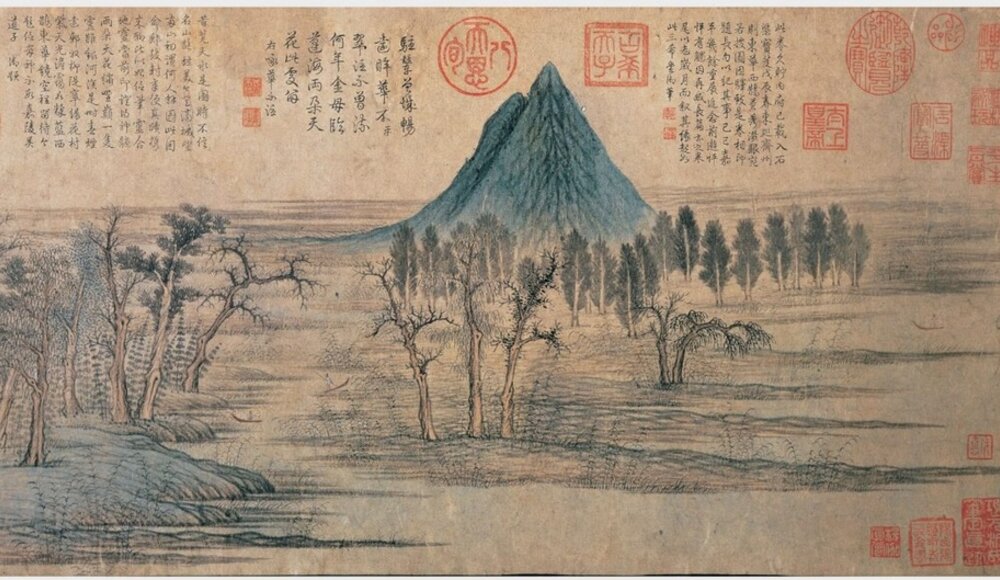
Chinese landscape paintings are deeply rooted in Daoist and Buddhist philosophy, which emphasize harmony, balance, and the interconnectedness of all things. By immersing themselves in the natural world and capturing its beauty on paper, Chinese artists seek to cultivate a sense of inner peace and spiritual enlightenment, transcending the limitations of the material world. Chinese landscape painting serves as a bridge between past and present, connecting us to the rich cultural heritage and artistic traditions of ancient China. As we gaze upon these sublime landscapes, let us marvel at the beauty of creation and the boundless creativity of the human spirit.
Image Courtesy – The Metropolitan Museum of Art
The Altering Landscapes of Culture and Religion in Iran Through Pre- and Post-Islamic Architecture

